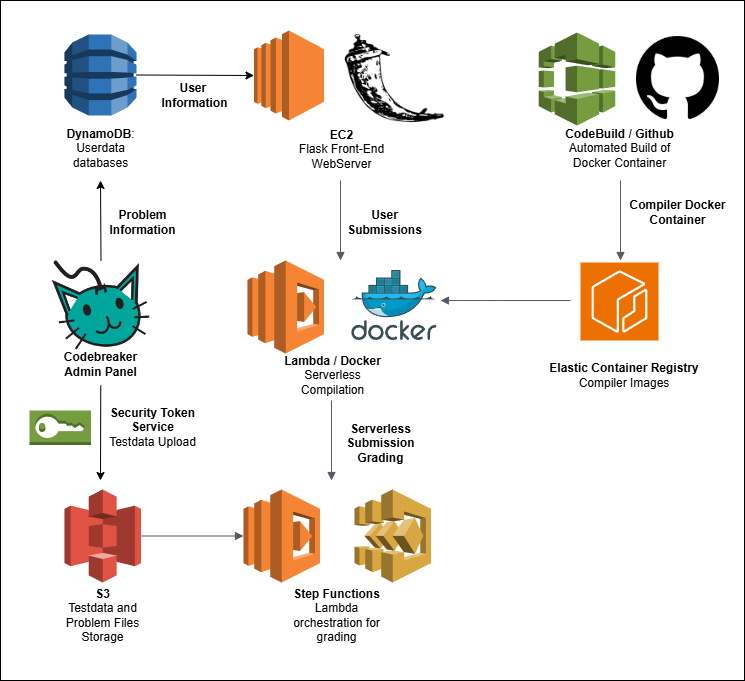Codebreaker is the official platform for Singapore Informatics Olympiad training and contests. It is home to 1,400 problems and over 3,000 users, and has performed national team selection for the International Olympiad of Informatics teams in Singapore and Indonesia.
The primary motivation for Singapore’s migration to Codebreaker is lowering operating costs. Despite having run for over 4 years and having graded hundreds of thousands of submissions, the total operational cost of Codebreaker is under $2000.
Codebreaker Contest System is a fork of the Codebreaker architecture that serves to allow for easy and independent usage of Codebreaker to run contests. In that way, Codebreaker Contest serves to be a more cost-efficient and more user-friendly version of the gold standard of contest organization and management, CMS. It is available at this link: https://github.com/dvdg6566/codebreaker-contest-manager/.
As of time of writing (June 2024), here are the statistics for Codebreaker (main site).
- Average traffic (Page requests) on CloudFlare per month is between 1,200,000 to 1,500,000
- Codebreaker has graded a total of 510,000 submissions.
- Codebreaker has 4,650 registerd users, coming from a 71 different countries
- Codebreaker has a total of 1,600 different problems, coming from a mixture of public sources and the Singapore training system.
Codebreaker runs on Amazon Web Services’ Serverless Architecture for compilation and grading of submissions. By abstracting away all of the heavy computation from the front-end web server, the web server thus only needs the resources necessary to support simple database API call operations and Flask hosting. This also avoids the need to over-provision resources, like having a large static server with a large number of workers running to perform grading.
To support problems with hundreds of testcases, we use Express Step Functions to orchestrate our Lambda workflow. This supports the concurrent invocations of hundreds of independent Lambda graders that will grade each of the testcases. This allows for extremely quick grading times for an optimal user interface. As per latest benchmark, the problem housevisit with 562 testcases is graded in about 11-12 seconds.
- The front-end web server is a Flask server running on an AWS Elastic Compute Cloud (EC2) instance. The server is deployed with Gunicorn and reverse proxied with Nginx.
- Codebreaker’s grading is performed serverlessly through an AWS Step Functions and AWS Lambda workflow. The steps are as follows:
- The submission is initialized and an entry created in DynamoDB.
- The submission is compiled with a custom Ubuntu OS Docker container that has GCC and Lambda installed.
a. Lambda relies on the container being built in the user’s Elastic Container Repository (ECR) instance. As such, CodeBuild will get the set-up scripts from Github and compile the container, before uploading it to ECR.
b. The same tech stack is also used for compilation of checkers. As such, Codebreaker supports
testlib.h, the industry-standard Competitve Programming checker and grader library. - Step Functions will concurrently invoke wrapper Lambda functions for testcase grading. This supports separation of permissions, allowing Lambda to function as a Sandbox for code execution before the wrapper will update the database. Note that the wrapper can have extremely low memory allocation, allowing for negligible compute costs.
- When all invocations have completed, a lambda function aggregates the testcase results and provides a final score.
- The main Codebreaker data storage uses AWS DynamoDB as a serverless database that stores user and problem data.
- Website functionality is provided through DynamoDB Global Secondary Indexes for fast and robust queries.
- AWS Simple Storage Service (S3) is used for file storage for testdata and submissions.
- S3 Lifecycle rules are used to transfer testcases from older problems to infrequent access storage tier to save costs.
- Testdata is uploaded through the admin panel. For each problem, an ephemeral IAM role is created with appropriate permissions that allows
PutItemaccess to a specific folder of the testdata bucket. Security Token Service (STS) is used to generate temporary AWS credentials that are passed to the front-end and uses the front-end SDK to upload the files. This allows for direct uploads to S3 with built-in multipart uploads.
- Contest announcements and notifications of incoming clarifications (for admins) is done through the use of AWS API Gateway. Front-end clients make SDK calls to an API Gateway WebSocket endpoint, which will be used to invoke the relevant notifications through AWS Lambda. This abstracts away web socket connections from the front-end server.
- User accounts and authentication are handled strictly through Google (Gmail) authentication.
If you are not using testlib.h, checker is called with
- input file (
argv[1]) - participant output file (
argv[2]) - jury output file (
argv[3])
The checker should output a real number between
If you are using testlib.h, the following is behaviour of the modified testlib.h (modification is in InStream::quit function starting at line 2596)
-
_ok: prints 1 -
_wa: prints 0 -
_pe: prints 0 -
_fail: prints nothing (checker fail) -
_dirt: prints 0 -
_points: prints custom error message that you specified. Example use isquitf(_points,"%.2f\n",0.69420);to give$69.42%$ of the subtask score -
__unexpected_eof: prints 0
